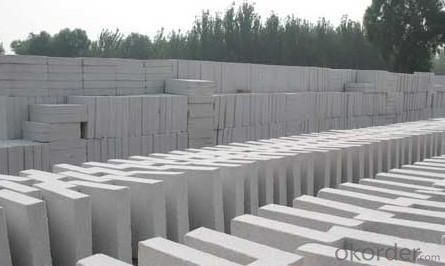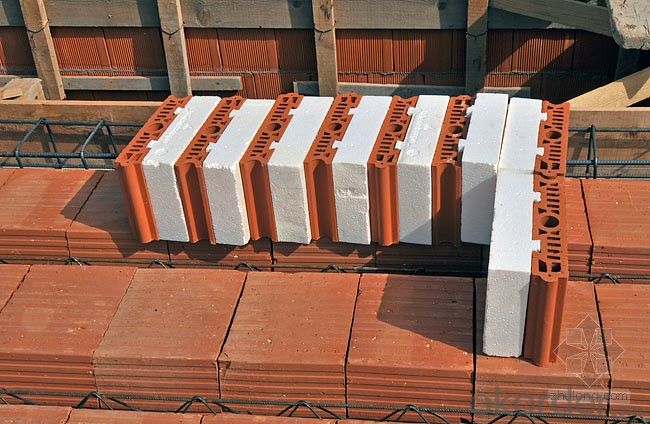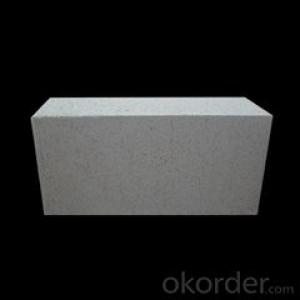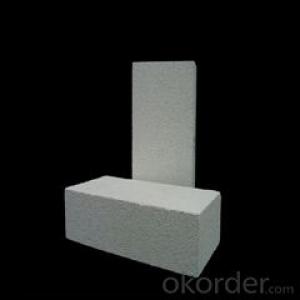Refractory mullite insulating refractory brick JM 97
- Loading Port:
- Shanghai
- Payment Terms:
- TT OR LC
- Min Order Qty:
- 5000 kg
- Supply Capability:
- 10000 kg/month
OKorder Service Pledge
OKorder Financial Service
You Might Also Like
Refractory mullite insulating refractory brick JM 23
Okorder series heat insulation brick
Okorder series thermal insulation brick is an effective, energy saving, low carbon, environmental protection advanced, according to the ASTM standard manufacturing products. Okorder series products are best Li Ning and insulation in all types of industrial furnaces in the metallurgical field, aluminum, petrochemical, electric power and glass ceramic materials. They can be used as part of the working layer of thermal insulation or non - melting. Products have been widely used in the following furnace, achieved satisfactory results.
Application of heat preservation brick
Metallurgical Industry: blast furnace, hot blast furnace, heating furnace, etc..
Petrochemical Industry: ethylene cracking furnace, hydrogen production furnace, primary reformer, heating furnace, etc..
Ceramic industry: roller kiln, kiln, etc..
Glass industry: glass furnace regenerator, etc.
Carbon industry: carbon furnace, etc..
Aluminum electrolysis industry: aluminum reduction cell, etc.
Other industries: tunnel kiln, shuttle kiln, etc..
Advantages of heat insulation brick
Low thermal conductivity: more porosity will bring good thermal insulation effect, energy saving.
High crushing strength: high crushing strength, volume stability.
Low heat storage: small heat storage to absorb more heat, energy-saving effect is obvious.
Gao Chundu: iron, alkali metal impurity content is low.
The precise size: Brick size processing precision, special shape cutting and grinding, accelerate the brickwork.
Insulating brick picture
Common problem solutions
1. What products do you have?
We have all kinds of refractory bricks, refractory casting materials, mortar, cement, ceramic fiber products, etc..
Or you can browse our products to choose what you need.
2. How to control product quality?
With strict quality control system throughout the material selection and production process, we have the quality of refractory materials and ceramic fiber products to meet customer requirements.
From the selection of raw materials, the quality of our control to start. The quality certificate of the raw material is required, each batch of the products are to be tested in the use of the forward line. In the production process, the quality control by the workers, and then each piece of classification, and through the quality supervision and inspection.
3. Can you give me a brief introduction to the application of your product?
My company is mainly engaged in refractories in the steel, cement, glass, ceramics, petrochemical, electric power and other industries.
4. What information do you need if I need you?
In order to select the right products, we will provide us with information, such as the United States, technical data, order quantity, product application, etc..
If you have any questions, please contact us.


- Q:Can insulating fire bricks be used in the construction of tundishes?
- Yes, insulating fire bricks can be used in the construction of tundishes. Insulating fire bricks are lightweight and have excellent thermal insulation properties, making them ideal for applications where heat retention is important. Tundishes, which are used in the steel industry to control the flow of molten metal, require materials that can withstand high temperatures and minimize heat loss. Insulating fire bricks can withstand the extreme temperatures found in tundishes, helping to maintain the desired temperature of the molten metal and preventing heat loss. Additionally, their lightweight nature makes them easier to handle and install in tundish construction. Overall, insulating fire bricks are a suitable choice for the construction of tundishes due to their thermal insulation properties and ability to withstand high temperatures.
- Q:The insulation layer destroyed after use of cement paste and tiling
- Attach tiles directly to the insulating layer. But one requirement is to check the insulation process in the balcony of your house. Usually wall - insulation layer - galvanized wire mesh - cement mortar, scraping - paint. If the lack of process fill such as galvanized mesh, remove paint, and tiling. You can use high mark cement or direct adhesive.
- Q:Can insulating fire bricks be used in combination with other insulation materials?
- Yes, insulating fire bricks can be used in combination with other insulation materials. They can be used as a primary insulation layer or in conjunction with other materials such as ceramic fiber insulation or refractory coatings to enhance insulation efficiency and achieve higher temperature resistance. This combination of insulation materials can provide better thermal insulation properties and increased energy efficiency in various applications such as furnaces, kilns, and high-temperature industrial processes.
- Q:Are insulating fire bricks resistant to abrasion or wear?
- Yes, insulating fire bricks are resistant to abrasion or wear. These bricks are made from high-quality refractory materials, such as alumina or silica, which have excellent resistance to abrasion. The manufacturing process involves high-temperature firing, which strengthens the bricks and enhances their durability. Insulating fire bricks are specifically designed to withstand the harsh conditions of high-temperature applications, such as furnaces, kilns, and fireplaces. They are highly resistant to thermal shock, chemical erosion, and mechanical wear. This makes them a reliable choice for insulating and protecting the inner walls of these structures, ensuring long-lasting performance and minimizing the need for frequent replacements.
- Q:Can insulating fire bricks be used in the construction of glass melting furnaces?
- Yes, insulating fire bricks can be used in the construction of glass melting furnaces. Insulating fire bricks are designed to have a high resistance to heat and are capable of withstanding extremely high temperatures. They have low thermal conductivity, which means they can effectively retain heat and minimize heat loss. In glass melting furnaces, where temperatures can reach up to 1600°C (2912°F) or even higher, insulating fire bricks play a crucial role in maintaining the desired temperature inside the furnace. By using insulating fire bricks as the furnace lining, the heat generated during the melting process can be efficiently contained within the furnace, allowing for better energy efficiency and reduced heat loss. Furthermore, insulating fire bricks are lightweight and have good thermal shock resistance, which makes them ideal for use in glass melting furnaces where rapid temperature changes are common. This ensures that the bricks will not crack or break under the extreme conditions of the furnace. Overall, the use of insulating fire bricks in the construction of glass melting furnaces provides better insulation, energy efficiency, and durability, making them a suitable choice for this application.
- Q:Are insulating fire bricks suitable for use in coke ovens?
- Coke ovens demand bricks capable of enduring exceedingly high temperatures and harsh chemical surroundings, rendering insulating fire bricks unsuitable for such purposes. Insulating fire bricks are primarily engineered to offer thermal insulation and lack the capability to withstand the heat and chemical exposure inherent in coke ovens. Consequently, it becomes imperative to employ refractory bricks custom-built for coke ovens, boasting exceptional resistance to temperature, chemical assaults, and thermal shock. Typically composed of robust materials like silica, alumina, and carbon, these refractory bricks exhibit remarkable resilience within the formidable conditions prevalent in coke ovens.
- Q:Can insulating fire bricks be used in the construction of pottery ovens?
- Insulating fire bricks are suitable for the construction of pottery ovens. They possess exceptional thermal properties, including low thermal conductivity and high heat resistance. These characteristics make them perfect for insulation and heat retention in pottery ovens, facilitating efficient and controlled firing of clay and ceramic materials. Furthermore, their lightweight nature simplifies handling and installation during construction. Ultimately, incorporating insulating fire bricks in pottery ovens ensures consistent and uniform heat distribution, leading to enhanced firing results and energy efficiency.
- Q:What is mullite insulation brick?
- Main features of mullite insulating bricks:1., green environmental protection, non-toxic, non corrosive, safe to use.2. 、 good adaptability with cement.3., light insulation brick with foam mechanism bubble, can get foam uniform bubble diameter.4. excellent foaming performance, foaming multiples of more than thirty times.
- Q:Are insulating fire bricks fire-rated?
- Yes, insulating fire bricks are fire-rated. They are specifically designed to withstand high temperatures and provide excellent thermal insulation in various applications. These bricks are made from a special type of ceramic material with low thermal conductivity, which allows them to retain heat and prevent it from transferring to the surrounding areas. This property makes them highly resistant to fire and helps protect the structures they are used in. Insulating fire bricks are commonly used in furnaces, kilns, fireplaces, and other high-temperature environments where fire protection is crucial.
- Q:Are insulating fire bricks suitable for use in glass melting furnaces?
- Depending on the requirements of the furnace and the type of glass being melted, insulating fire bricks may be a suitable option for glass melting furnaces. These fire bricks are constructed from lightweight materials that have low thermal conductivity, enabling them to effectively retain heat and minimize energy loss in the furnace. This, in turn, can enhance the furnace's energy efficiency and decrease operational expenses. Nevertheless, it is essential to take into account the temperature and atmosphere within the glass melting furnace when selecting the appropriate insulating fire bricks. Glass melting furnaces function at extremely high temperatures, often surpassing 1500°C (2732°F). Some insulating fire bricks may not be capable of enduring such elevated temperatures and could deteriorate or even melt under these circumstances. Furthermore, the atmosphere within the glass melting furnace can influence the suitability of the insulating fire bricks. Certain types of these fire bricks may interact with specific gases or chemicals present in the furnace atmosphere, leading to degradation or contamination of the molten glass. Hence, it is crucial to choose insulating fire bricks that are compatible with the precise atmosphere and conditions within the glass melting furnace. To summarize, insulating fire bricks can be appropriate for use in glass melting furnaces, but careful consideration must be given to their temperature resistance and compatibility with the furnace atmosphere. Seeking guidance from specialists or suppliers who specialize in refractory materials for glass melting furnaces can help ensure the appropriate selection of insulating fire bricks for optimal furnace performance and glass quality.
1. Manufacturer Overview |
|
|---|---|
| Location | |
| Year Established | |
| Annual Output Value | |
| Main Markets | |
| Company Certifications | |
2. Manufacturer Certificates |
|
|---|---|
| a) Certification Name | |
| Range | |
| Reference | |
| Validity Period | |
3. Manufacturer Capability |
|
|---|---|
| a)Trade Capacity | |
| Nearest Port | |
| Export Percentage | |
| No.of Employees in Trade Department | |
| Language Spoken: | |
| b)Factory Information | |
| Factory Size: | |
| No. of Production Lines | |
| Contract Manufacturing | |
| Product Price Range | |
Send your message to us
Refractory mullite insulating refractory brick JM 97
- Loading Port:
- Shanghai
- Payment Terms:
- TT OR LC
- Min Order Qty:
- 5000 kg
- Supply Capability:
- 10000 kg/month
OKorder Service Pledge
OKorder Financial Service
Similar products
New products
Hot products
Related keywords




























